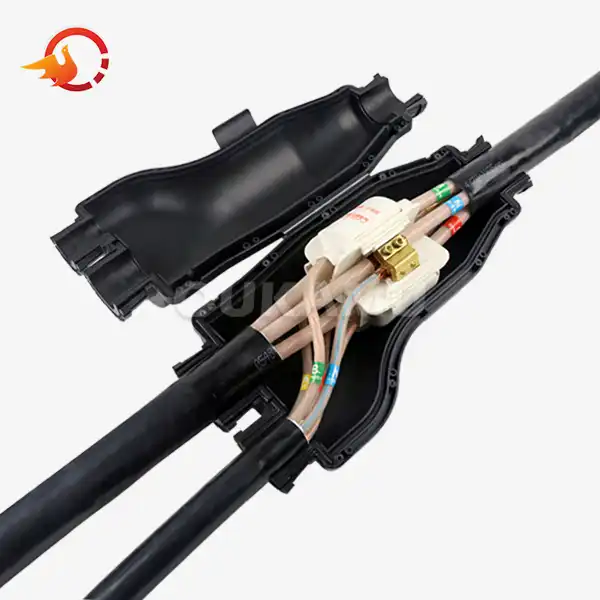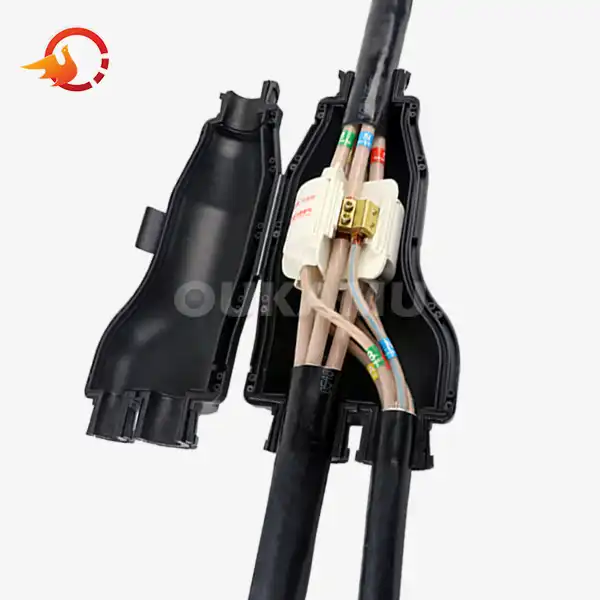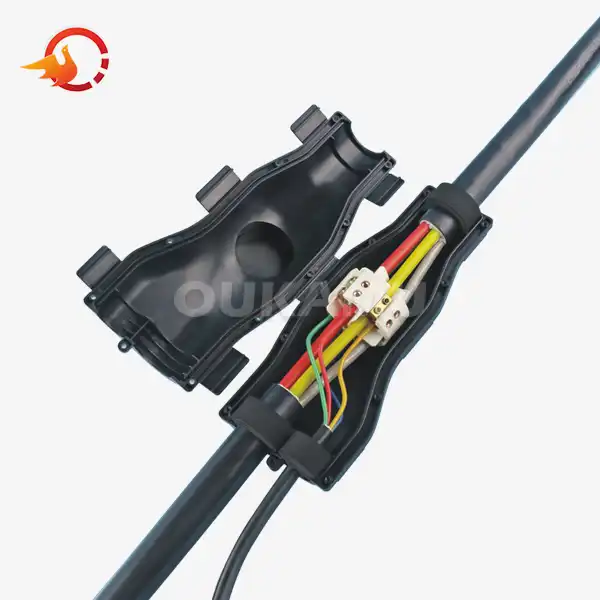Understanding the Classification of Underground Cables
 2025-11-11 15:56:52
View:389
2025-11-11 15:56:52
View:389Underground cables play a crucial role in modern power distribution systems, offering numerous advantages over traditional overhead lines. As urban landscapes evolve and the demand for reliable electricity increases, understanding the various types and applications of underground cables becomes increasingly important. In this comprehensive guide, we'll explore the classification of underground cables, their applications in power systems, and the key advantages they offer.
Types of Underground Cable Based on Voltage
Underground cables are classified into different categories based on their voltage ratings. These classifications help engineers and technicians select the appropriate cable for specific applications, ensuring optimal performance and safety. Let's delve into the main types of underground cables based on voltage:
Low Voltage (LV) Cables
Low voltage cables are designed to carry electricity at voltages up to 1000V. These cables are commonly used in residential and commercial buildings for power distribution to various electrical appliances and lighting systems. LV cables are typically insulated with materials such as PVC or XLPE and may include armoring for additional protection.
Medium Voltage (MV) Cables
Medium voltage cables operate in the range of 1kV to 33kV and are extensively used in urban power distribution networks. These cables connect substations to transformers and are crucial for supplying electricity to neighborhoods and industrial areas. MV cables often feature advanced insulation materials like XLPE and may incorporate metallic screens for enhanced performance.
High Voltage (HV) Cables
High voltage cables are designed to transmit power at voltages ranging from 33kV to 230kV. These cables are used for long-distance power transmission and in substations where high voltage electricity is stepped down for distribution. HV cables require sophisticated insulation systems and may utilize oil-filled or gas-pressurized designs for optimal performance.
Extra High Voltage (EHV) Cables
Extra high voltage cables operate at voltages exceeding 230kV and are used for bulk power transmission over long distances. These cables are highly specialized and require advanced manufacturing techniques to ensure reliable operation under extreme electrical stress. EHV cables often incorporate advanced cooling systems and sophisticated insulation materials to maintain their performance.
Applications of Underground Cable in Power Systems
Underground cables find extensive use in various sectors of the power industry, offering reliable and efficient solutions for electricity transmission and distribution. Let's explore some of the key applications of underground cables in power systems:
Urban Power Distribution
In densely populated urban areas, underground cables are the preferred choice for power distribution. They offer several advantages over overhead lines, including improved aesthetics, reduced electromagnetic interference, and enhanced reliability during adverse weather conditions. OUKAMU's cable branch technology has been successfully implemented in urban power distribution networks, providing efficient and flexible solutions for complex city landscapes.
Industrial Power Supply
Industrial facilities often require high-capacity power supply systems that can withstand harsh environments. Underground cables are ideal for such applications, as they can be routed through conduits or directly buried, providing a secure and reliable power supply to critical equipment. The durability and adaptability of OUKAMU's cable connection products make them particularly suitable for industrial power supply applications.
Renewable Energy Integration
As the world transitions towards cleaner energy sources, underground cables play a vital role in integrating renewable energy systems into existing power grids. Solar farms and offshore wind parks often utilize underground cables to transmit generated electricity to substations and distribution networks. OUKAMU's innovative cable branch solutions facilitate efficient connection and distribution of renewable energy, supporting the global shift towards sustainable power generation.
Submarine Power Transmission
Underwater power cables are essential for connecting offshore installations and islands to mainland power grids. These specialized underground cables are designed to withstand the harsh marine environment and high pressures at great depths. While not directly related to OUKAMU's product line, the principles of efficient cable connections apply equally to submarine power transmission systems.
Transportation Electrification
As electric vehicles gain popularity, the demand for charging infrastructure is increasing. Underground cables are crucial for supplying power to charging stations in urban areas and along highways. OUKAMU's cable connection solutions offer the flexibility needed to expand and adapt charging networks as the adoption of electric vehicles continues to grow.
Key Advantages of Using Underground Cable
Underground cables offer numerous benefits over traditional overhead lines, making them an increasingly popular choice for power distribution and transmission. Let's explore the key advantages of using underground cables:
Enhanced Reliability
One of the primary advantages of underground cables is their increased reliability. By being buried beneath the surface, these cables are protected from various environmental factors that can affect overhead lines, such as:
- Severe weather conditions (storms, high winds, ice)
- Falling trees or branches
- Wildlife interference
- Vandalism or accidental damage
This protection translates to fewer power outages and a more stable electricity supply for consumers. OUKAMU's cable branch technology further enhances this reliability by providing secure and efficient connections within underground cable networks.
Improved Safety
Underground cables significantly reduce the risk of electrical accidents compared to overhead lines. The buried cables eliminate the dangers associated with:
- Accidental contact with live wires
- Fallen power lines during storms
- Electrical fires caused by external factors
This increased safety is particularly important in densely populated areas or locations with frequent severe weather events. OUKAMU's focus on developing safe and reliable cable connection products aligns perfectly with this advantage of underground cable systems.
Aesthetic Appeal
In urban and suburban environments, the visual impact of power infrastructure is an important consideration. Underground cables offer a clear aesthetic advantage by eliminating the need for unsightly overhead power lines and poles. This results in:
- Cleaner, more attractive cityscapes
- Preservation of natural scenery
- Increased property values in residential areas
By enabling efficient underground cable installations, OUKAMU's products contribute to the improved visual appeal of modern urban environments.
Space Efficiency
Underground cables require significantly less space than overhead line systems. This space efficiency is particularly valuable in:
- Densely populated urban areas
- Locations with height restrictions (e.g., near airports)
- Areas with limited right-of-way availability
The compact nature of underground cable systems, combined with OUKAMU's space-efficient cable branch solutions, allows for more flexible urban planning and development.
Reduced Electromagnetic Fields
Underground cables generate lower electromagnetic fields (EMF) compared to overhead lines. This reduction in EMF is beneficial for:
- Minimizing potential health concerns
- Reducing interference with sensitive electronic equipment
- Complying with increasingly stringent EMF regulations
OUKAMU's cable connection products are designed to maintain the low EMF characteristics of underground cable systems, ensuring optimal performance in this regard.
Lower Maintenance Requirements
Once installed, underground cables typically require less maintenance than overhead lines. This advantage stems from:
- Protection from environmental factors
- Reduced exposure to physical damage
- Longer lifespan of underground cable systems
The durability and reliability of OUKAMU's cable branch technology contribute to the overall low maintenance requirements of underground cable networks.
Flexibility in Urban Planning
Underground cables offer greater flexibility in urban planning and development. This flexibility allows for:
- Easier integration of power infrastructure in new developments
- More efficient use of land in urban areas
- Adaptability to changing power distribution needs
OUKAMU's innovative cable branch solutions enhance this flexibility by allowing for easy modifications and expansions of existing underground cable networks.
Resistance to Extreme Weather
Underground cables are inherently more resistant to extreme weather conditions than overhead lines. This resistance provides:
- Improved reliability during storms, hurricanes, and ice events
- Reduced vulnerability to climate change impacts
- Lower risk of widespread power outages due to weather-related incidents
By ensuring secure and reliable connections, OUKAMU's products contribute to the overall weather resistance of underground cable systems.
Long-Term Cost-Effectiveness
While the initial installation costs of underground cables may be higher than those of overhead lines, they often prove more cost-effective in the long run due to:
- Reduced maintenance and repair costs
- Lower power losses in transmission
- Increased lifespan of the cable system
- Fewer outages and associated economic losses
OUKAMU's efficient and durable cable connection solutions contribute to the long-term cost-effectiveness of underground cable installations.
Conclusion
Understanding the classification of underground cables is essential for anyone involved in power system design, installation, or maintenance. From low voltage cables used in residential settings to extra high voltage cables for long-distance power transmission, each type plays a crucial role in our modern electrical infrastructure. The numerous applications of underground cables across various sectors highlight their versatility and importance in today's power systems.
The key advantages of using underground cables, such as enhanced reliability, improved safety, and aesthetic appeal, make them an increasingly popular choice for power distribution and transmission. As urban areas continue to grow and the demand for reliable electricity increases, the role of underground cables in our power infrastructure will only become more significant.
OUKAMU's innovative cable branch technology and high-quality cable connection products are at the forefront of this evolving landscape. By providing flexible, efficient, and reliable solutions for underground cable networks, OUKAMU is contributing to the development of more resilient and sustainable power distribution systems. For more information about OUKAMU's cable connection products and how they can benefit your underground cable projects, please contact us at info@okmbranchcable.com.
FAQ
Q: What are the main advantages of underground cables over overhead lines?
A: Underground cables offer enhanced reliability, improved safety, better aesthetics, space efficiency, reduced electromagnetic fields, lower maintenance requirements, and greater resistance to extreme weather conditions.
Q: How do OUKAMU's cable branch products contribute to underground cable systems?
A: OUKAMU's cable branch technology provides flexible, efficient, and reliable connections for underground cable networks, enhancing system performance and adaptability.
Q: Are underground cables suitable for all voltage levels?
A: Yes, underground cables are available for various voltage levels, from low voltage (up to 1000V) to extra high voltage (exceeding 230kV), catering to different power distribution and transmission needs.
References
1. Anders, G. J. (2018). Rating of Electric Power Cables: Ampacity Calculations for Transmission, Distribution, and Industrial Applications (2nd ed.). IEEE Press.
2. Haddad, A., & Warne, D. F. (Eds.). (2020). Advances in High Voltage Engineering. Institution of Engineering and Technology.
3. International Electrotechnical Commission (IEC). (2019). IEC 60502-1: Power cables with extruded insulation and their accessories for rated voltages from 1 kV (Um = 1.2 kV) up to 30 kV (Um = 36 kV). Geneva: IEC.
4. Marzinotto, M., Mazzanti, G., & Zanetto, G. (2013). Underground Power Cables: Design, Installation and Diagnostics. Springer.
5. IEEE Power & Energy Society. (2017). IEEE Std 576-2017: IEEE Guide for the Application of Sheath-Bonding Methods for Single-Conductor Cables and the Calculation of Induced Voltages and Currents in Cable Sheaths. New York: IEEE.















